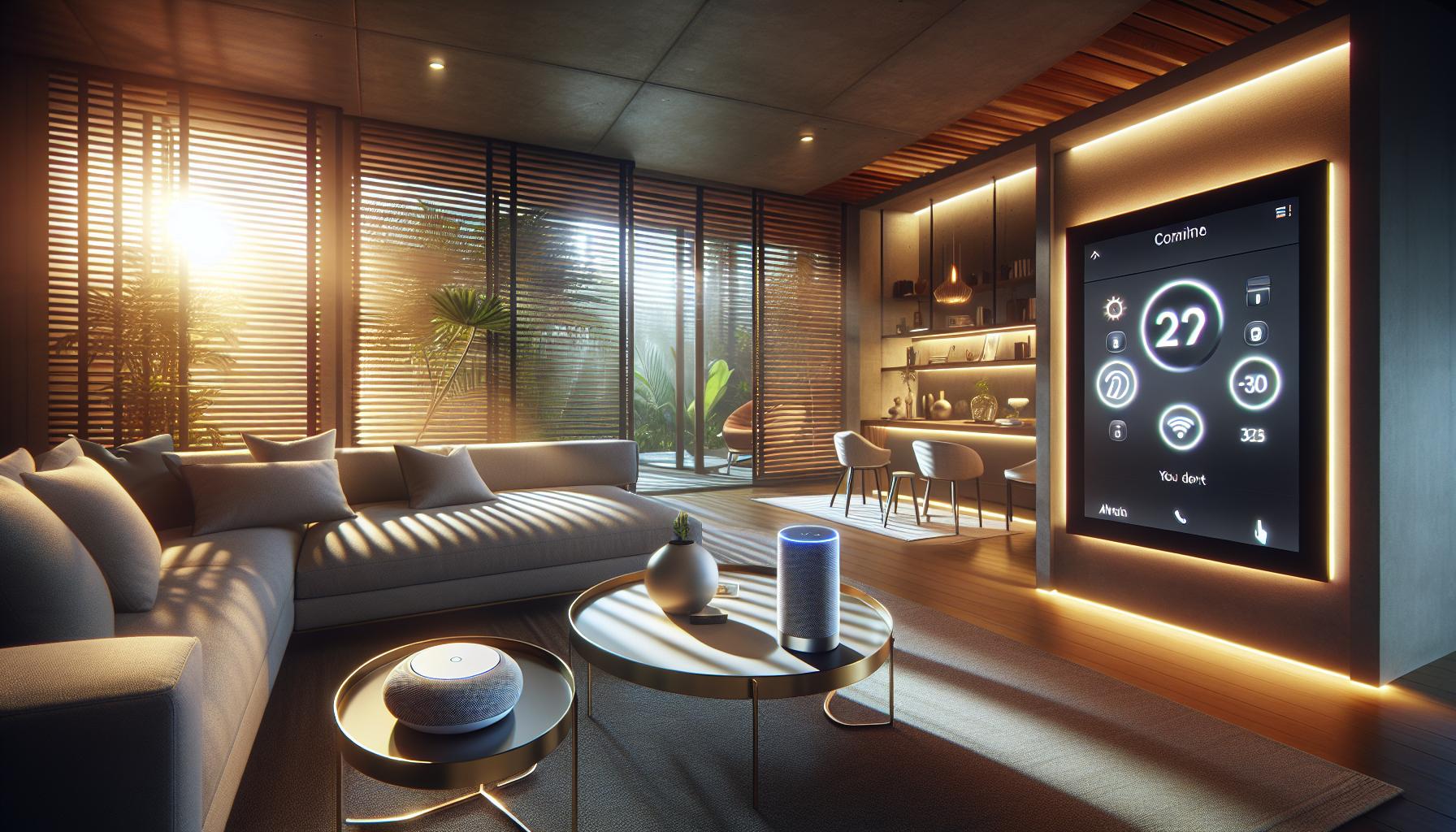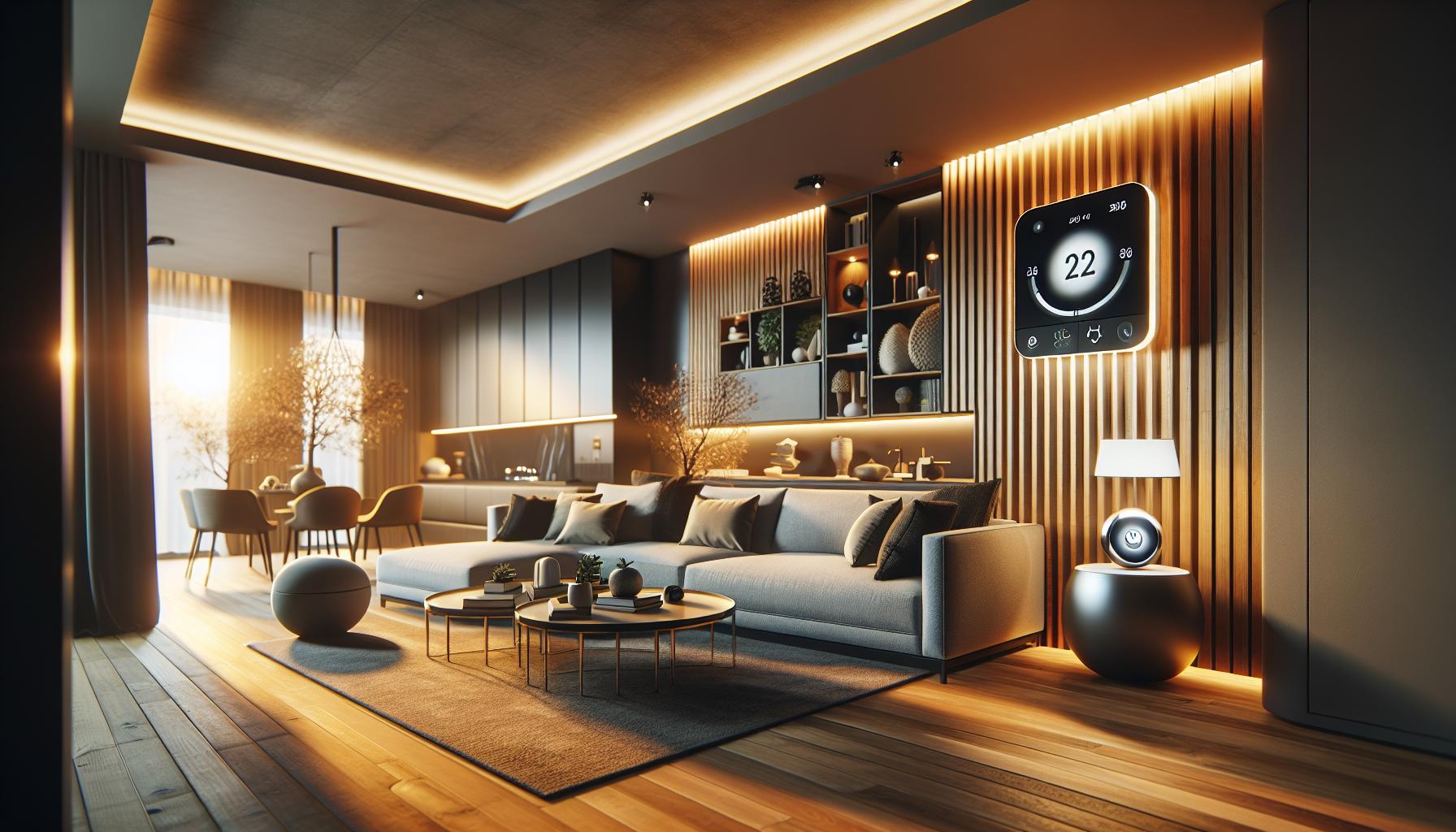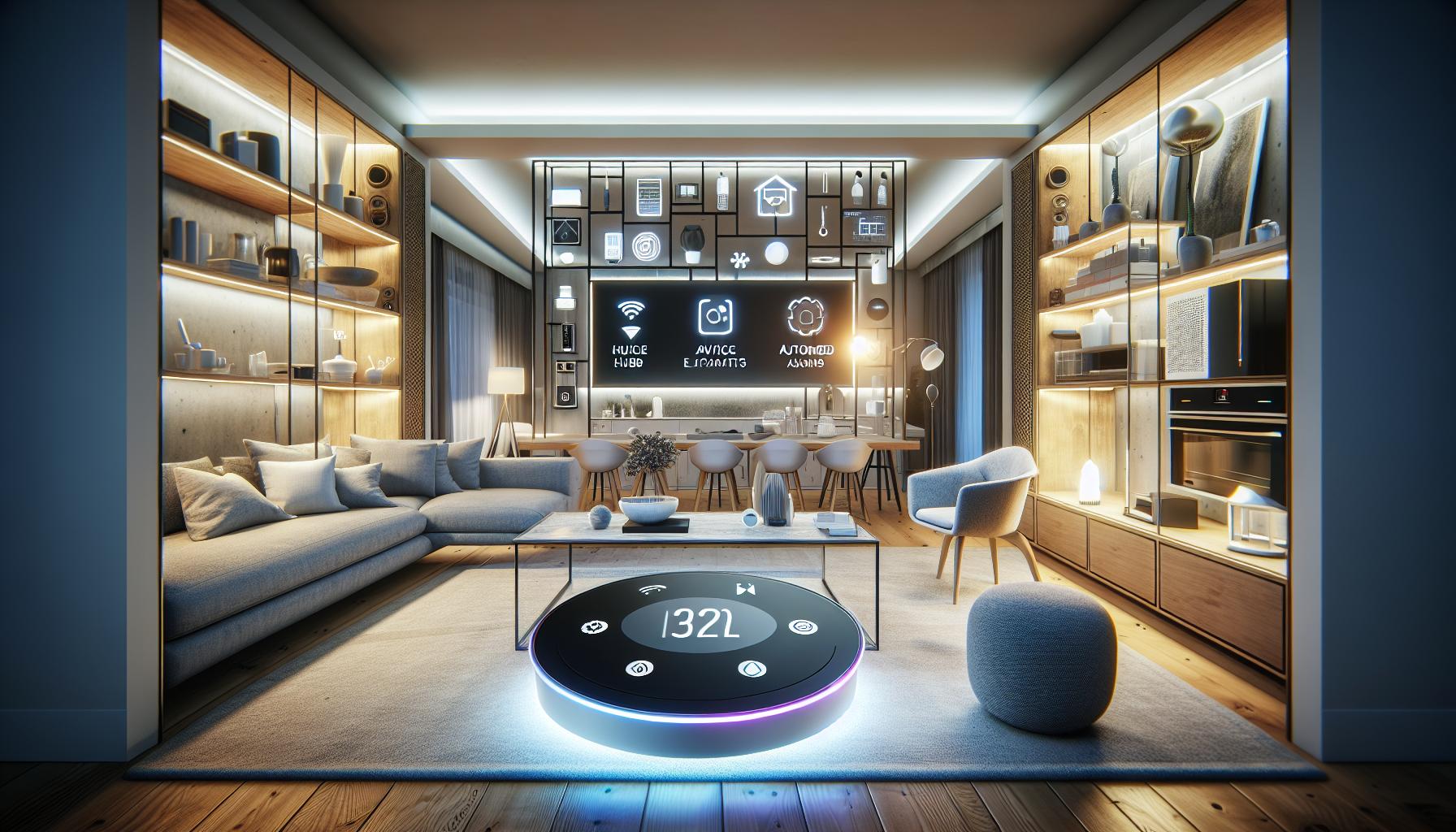Key Takeaways
- Enhanced Convenience: Smart home devices streamline daily tasks, from automated lighting to smart thermostats, making life easier and more efficient for homeowners.
- Improved Security: Innovative security features like smart cameras and locks provide real-time monitoring and control, ensuring peace of mind and enhancing home safety.
- Energy Efficiency: Smart technologies, such as energy management systems and smart thermostats, optimize energy usage, helping homeowners save on utility bills and reduce their carbon footprint.
- Integration and Automation: Home automation systems connect various devices, allowing seamless control and custom routines that enhance daily living experience.
- Voice Control Technology: Devices like voice assistants serve as central hubs, enabling hands-free control and simplifying interactions with smart home systems.
- Future Trends: Emerging technologies, such as AI integration and sustainable devices, are shaping the future of smart homes, offering greater personalization, efficiency, and environmental responsibility.
In today’s fast-paced world, smart home technology is transforming the way people live. With innovations emerging daily, homeowners are discovering exciting ways to enhance convenience, security, and energy efficiency. From voice-activated assistants to intelligent lighting systems, the possibilities are endless.
As technology evolves, so do the creative ideas that make homes not just smarter but also more enjoyable. Whether it’s integrating smart appliances into daily routines or utilizing advanced security features, these new concepts cater to diverse lifestyles and preferences. Embracing these innovations can lead to a more connected and efficient living space, making everyday tasks simpler and more enjoyable.
New Smart Home Ideas
New smart home ideas revolve around enhancing daily living through advanced technology. Homeowners can explore various options to elevate convenience, security, and energy efficiency.
Smart Lighting Systems
Smart lighting systems enable homeowners to control brightness and color from smartphones or voice-activated devices. Many systems offer scheduling features, allowing lights to turn on or off automatically, which aids in energy savings.
Smart Thermostats
Smart thermostats learn user preferences and adapt accordingly. These devices optimize heating and cooling, significantly reducing energy consumption, while providing remote access through mobile applications.
Home Security Cameras
Home security cameras with smart features provide real-time monitoring and alerts. Users can view live footage from their phones and receive notifications of unusual activity, enhancing home security.
Automated Blinds
Automated blinds adjust according to the time of day or temperature settings. This feature helps regulate indoor temperatures and maintain privacy with minimal manual effort.
Smart Appliances
Smart appliances, such as refrigerators and ovens, offer connectivity and monitoring capabilities. Users can check inventory, set cooking reminders, and control appliances remotely, streamlining meal preparations.
Voice Assistants
Voice assistants serve as central hubs for smart home devices, allowing seamless control through voice commands. They facilitate hands-free operation, enhancing user experience while interacting with various technologies.
Smart Sensors
Smart sensors monitor environmental conditions, detecting changes in temperature or humidity. These can trigger alerts and automate HVAC systems, promoting a healthier home environment.
Energy Management Systems
Energy management systems provide insights into energy consumption patterns. Homeowners can access detailed reports to track usage and identify opportunities for conservation and efficiencies.
Smart Locks
Smart locks enhance security with keyless entry options and remote access. These locks allow homeowners to grant entry temporarily to guests or service personnel, all managed through mobile applications.
These innovative smart home ideas improve overall quality of life by incorporating technology that aligns with modern needs. Homeowners increasingly find such solutions beneficial for creating a more connected and efficient living environment.
Benefits of Smart Home Technology

Smart home technology offers numerous advantages, simplifying daily tasks and improving living standards. Its innovations enhance convenience and security for homeowners.
Enhanced Convenience
Enhanced convenience allows for seamless control over multiple devices. Homeowners can automate lighting, heating, and appliances, adjusting settings remotely. For example, smart lighting systems enable users to change brightness and color via a smartphone app. Smart thermostats learn preferences, automatically optimizing energy usage throughout the day. Automated blinds adjust based on sunlight, maintaining comfortable indoor temperatures. Voice assistants serve as central hubs, enabling voice commands for various devices. This integration streamlines daily routines, making everyday tasks more manageable.
Improved Security
Improved security features provide peace of mind for homeowners. Smart security cameras offer real-time monitoring, sending alerts to users’ smartphones for any unusual activity. Smart locks enhance access control through keyless entry and remote locking capabilities. Homeowners can grant temporary access to visitors while monitoring their comings and goings. Motion sensors provide alerts for movement detection, triggering notifications when needed. Additionally, smart doorbells with video capabilities let homeowners see and communicate with visitors remotely, further enhancing security. Together, these technologies create layers of safety and control for modern living environments.
Innovative Smart Home Devices

Smart home devices continue to transform everyday living by offering advanced features that enhance comfort and efficiency. Below are some notable innovations that homeowners can integrate into their environments.
Smart Lighting Systems
Smart lighting systems enable users to control brightness, color, and scheduling through smartphone applications or voice commands. These systems support various lighting options, such as LED bulbs and smart switches, which can be programmed to respond to user behavior. For example, homeowners can set lights to gradually brighten in the morning, mimicking natural sunlight, or create a cozy ambiance for evening relaxation. Additionally, integration with home automation systems allows for remote access, so lighting can be adjusted even when away from home.
Smart Thermostats
Smart thermostats learn user preferences and adjust heating and cooling accordingly, optimizing energy consumption. These devices analyze historical data and real-time environmental conditions to create personalized schedules. For instance, a smart thermostat can lower temperatures when the house is unoccupied and raise them before residents return. Many models offer mobile application controls, enabling adjustments from anywhere. Some even provide energy usage reports, helping homeowners track and improve energy efficiency.
Smart Security Cameras
Smart security cameras enhance home safety through real-time monitoring and alerts. Equipped with features like motion detection and night vision, these devices provide comprehensive surveillance of property perimeters. Homeowners can access live feeds via mobile apps, ensuring peace of mind at all times. Many smart cameras also include cloud storage options, enabling easy access to recorded footage. Integration with other smart home devices, such as smart locks and motion sensors, creates a cohesive security system tailored to user needs.
Integrating Smart Home Ideas

Integrating smart home ideas enhances the functionality and efficiency of modern living spaces. The use of advanced technology in home automation and voice-controlled systems improves user experience and convenience.
Home Automation Systems
Home automation systems streamline daily routines by connecting various devices for a cohesive operation. Systems enable homeowners to automate lighting, climate control, entertainment, and security, providing seamless integration and control. Popular systems include:
- Zigbee and Z-Wave: Protocols that allow different devices to communicate, enhancing interoperability among smart devices.
- Smart Hubs: Centralized platforms like Samsung SmartThings and Amazon Echo show that various devices can be controlled from a single interface.
- Scheduled Routines: Homeowners can set up specific routines for devices, such as turning lights on at sunset or adjusting thermostats before arrival.
With automated settings, energy usage decreases, and users enjoy tailored experiences that fit their lifestyles.
Voice-Controlled Assistants
Voice-controlled assistants redefine interaction with smart home technology. Devices like Amazon Echo, Google Nest, and Apple HomePod allow users to issue commands hands-free. Key features include:
- Central Control: Voice assistants serve as central hubs, enabling users to manage lighting, music, and smart appliances through simple voice commands.
- Personalized Responses: Assistants can learn preferences, providing customized suggestions for routines and adjustments.
- Integration with Third-Party Devices: Compatibility with a wide range of smart devices facilitates easy expansion of the smart home ecosystem.
Utilizing voice-controlled assistants promotes a more intuitive and engaging user experience, setting the foundation for a fully integrated smart home.
Future Trends in Smart Home Technology
Smart home technology continues to evolve, and several trends are shaping the future. Notable advancements include:
- AI-Enhanced Devices: AI integration allows devices to learn user behaviors, leading to increased personalization and automation. For example, smart thermostats use machine learning to adapt to a homeowner’s schedule.
- Interoperability: Devices from different manufacturers can seamlessly communicate. Standards like Matter facilitate cross-device compatibility, creating a cohesive smart home ecosystem.
- Energy Management Solutions: Smart energy systems analyze consumption patterns, giving homeowners valuable insights. These solutions help optimize energy use, contributing to sustainability and cost savings.
- Health Monitoring: Smart technology extends into health with devices that track air quality, humidity levels, and even sleep patterns. These innovations promote well-being and enhance comfort at home.
- Remote Monitoring and Management: Enhanced remote access options allow homeowners to control systems from anywhere. Advanced security cameras and smart appliances offer real-time feedback and alerts, further improving oversight.
- Voice Interaction Advancements: Voice technology continues to improve, with better natural language processing. This evolution enhances user experience, allowing for more intuitive interactions with smart devices.
- Home Automation as a Service: Subscription-based services for smart home automation offer a range of customizable solutions without the need for hefty upfront investments. These services enhance accessibility for a broader audience.
- Sustainable Devices: Increased focus on environmental responsibility leads to the development of energy-efficient appliances and systems. Smart devices that monitor and reduce energy consumption align with sustainability goals.
These trends indicate a future where smart home technology seamlessly integrates into daily life, enhancing convenience, security, and sustainability. Homeowners can expect continued innovation that transforms their living spaces into smarter, more efficient environments.
New Smart Home Ideas
Embracing new smart home ideas can significantly transform daily living experiences. By integrating advanced technology into homes, individuals can enjoy greater convenience and enhanced security. The continuous evolution of smart devices ensures that homeowners have access to innovative solutions tailored to their lifestyles.
As smart technology becomes more accessible, the potential for increased energy efficiency and improved quality of life grows. With features like automated lighting and intelligent thermostats, managing a home is simpler than ever. The future of smart homes looks promising, paving the way for a more connected and sustainable living environment. Homeowners can look forward to a seamless blend of comfort, security, and efficiency in their everyday lives.